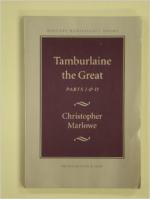|
This section contains 521 words (approx. 2 pages at 400 words per page) |

|
Blank Verse
In his prefatory tribute to the first folio edition of Shakespeare's plays, Ben Jonson cited (though in deference to Shakespeare) "Marlowe's mighty line," and critics tend to agree that Marlowe's innovation in verse was the first and most influential predecessor to the stylistic achievements of the era. It was Tamburlaine the Great that made this powerful verse style famous. Marlowe stresses in the prologue to part 1 that it is his intention to depart from the "jigging veins of rhyming mother wits," or unsophisticated rhymes like those of a mother giving silly advice in the form of a jig, of his predecessors. Instead, Marlowe wanted to create a work of high philosophical ambitions and powerful, "astounding" verse.
The poetic tool Marlowe uses for his "mighty line" is blank verse, or unrhymed iambic pentameter, which is a meter with five beats of two-syllable units called iambs. This style, adapted...
|
This section contains 521 words (approx. 2 pages at 400 words per page) |

|




